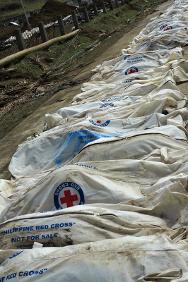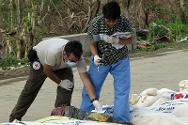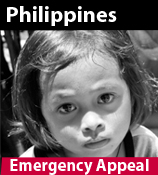Philippines: Helping identify the dead
19-11-2013 News Release 13/204
Geneva/Manila (ICRC) – The violence with which Typhoon Haiyan struck resulted in the loss of many lives and caused many people to go missing. The International Committee of the Red Cross (ICRC) immediately sent a forensic expert to advise, coordinate and cooperate with the Philippine authorities on the proper management of the dead.
"There are certain procedures that should be followed to preserve the dignity of the victims and facilitate their identification," said Andres Patiño, the ICRC's expert in humanitarian forensic action and the first forensic specialist to arrive in Tacloban. "The dead should be properly collected and placed in temporary burial places, to allow for forensic investigation later. Photographs should be taken, and any descriptive information and post-mortem data should be recorded."
In the current circumstances, with electricity and other basic necessities unavailable and most facilities destroyed, ensuring that these procedures are followed is very challenging. "At a meeting yesterday with the local authorities of Tacloban and the Department of Health, we agreed on an emergency plan for the proper management of the dead which takes into account the scarcity of available resources."
The authorities have agreed to follow guidelines for the management of the dead developed jointly by the ICRC and the World Health Organization (WHO). The ICRC is closely coordinating its forensic action in the Philippines with the WHO through the Ministry of Health and also with the National Bureau of Investigations.
There is no public health justification for rapid mass burials. Contrary to what many people believe, the bodies of those who die in a natural disaster do not cause epidemics, and they are a negligible health hazard. It is probable that most victims of Typhoon Haiyan died of injury, drowning or fire; they are not likely to have had epidemic-causing diseases such as cholera, typhoid, malaria or the plague when they died. "There is only a small risk of developing diarrhoea by drinking water contaminated by the corpses – a risk smaller than that caused by the living – and that risk can be eliminated by routinely disinfecting and/or boiling water to prevent water-borne disease," said the ICRC expert. "In any case, most people avoid drinking water from any source that may have been in contact with dead bodies or other causes of contamination."
Hasty and uncoordinated burials of the dead without proper identification are a concern for the authorities and the ICRC, as they can be very painful for the bereaved. Improper and undignified management of the dead can traumatize families and communities, and may have serious legal consequences, as it may be impossible to recover and identify the remains later. The victims will simply be missing.
"People feel an overwhelming need to know what happened to their missing relatives," said Nancy Fournier of the ICRC delegation in Manila. "Families with no information on the whereabouts of loved ones are grief-stricken. Giving them the possibility to identify their missing relative – even dead – is crucial. They need to know what happened to be able to start mourning. That's why it is so important to handle remains carefully."
Around 35,000 people within the Philippines and beyond have so far asked the Philippine Red Cross to trace family members who have gone missing in connection with Typhoon Haiyan.
For further information, please contact:
Soaade Messoudi, ICRC Manila, tel: +63 918 907 2125
Cecilia Goin, ICRC Manila, tel: +63 999 887 0969
Allison Lopez, ICRC Manila, tel: +63 908 868 6884
Anastasia Isyuk, ICRC Geneva, tel: +41 22 730 30 23 or +41 79 251 93 02



